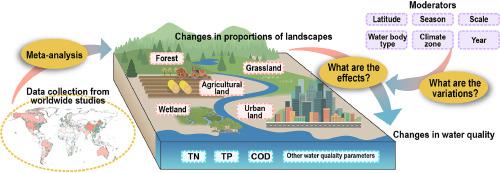当前位置:
X-MOL 学术
›
Water Res.
›
论文详情
Our official English website, www.x-mol.net, welcomes your feedback! (Note: you will need to create a separate account there.)
Effects of landscape changes on water quality: A global meta-analysis
Water Research ( IF 11.4 ) Pub Date : 2024-06-14 , DOI: 10.1016/j.watres.2024.121946 Xinying Shi , Dehua Mao , Kashan Song , Hengxing Xiang , Sijia Li , Zongming Wang
Water Research ( IF 11.4 ) Pub Date : 2024-06-14 , DOI: 10.1016/j.watres.2024.121946 Xinying Shi , Dehua Mao , Kashan Song , Hengxing Xiang , Sijia Li , Zongming Wang

|
Landscape changes resulting from anthropogenic activities and climate changes severely impact surface water quality. A global perspective on understanding their relationship is a prerequisite for pursuing equity in water security and sustainable development. A sequent meta-analysis synthesizing 625 regional studies from 63 countries worldwide was conducted to analyze the impacts on water quality from changing landscape compositions in the catchment and explore the moderating factors and temporal evolution. Results exhibit that total nitrogen (TN), total phosphorus (TP), and chemical oxygen demand (COD) in water are mostly concerned and highly responsive to landscape changes. Expansion of urban lands fundamentally degraded worldwide water quality over the past 20 years, of which the arid areas tended to suffer more harsh deterioration. Increasing forest cover, particularly low-latitude forests, significantly decreased the risk of water pollution, especially biological and heavy metal contamination, suggesting the importance of forest restoration in global urbanization. The effect size of agricultural land changes on water quality was spatially scale-dependent, decreasing and then increasing with the buffer radius expanding. Wetland coverage positively correlated with organic matter in water typified by COD, and the correlation coefficient peaked in the boreal areas (r=0.82, 0.01). Overall, the global impacts of landscape changes on water quality have been intensifying since the 1990s. Nevertheless, knowledge gaps still exist in developing areas, especially in Africa and South America, where the water quality is sensitive to landscape changes and is expected to experience dramatic shifts in foreseeable future development. Our study revealed the worldwide consistency and heterogeneity between regions, thus serving as a research roadmap to address the quality-induced global water scarcity under landscape changes and to direct the management of land and water.
中文翻译:

景观变化对水质的影响:全球荟萃分析
人类活动和气候变化引起的景观变化严重影响地表水质量。从全球角度理解它们之间的关系是追求水安全和可持续发展公平的先决条件。随后进行的荟萃分析综合了来自全球 63 个国家的 625 项区域研究,以分析流域景观组成变化对水质的影响,并探索调节因素和时间演变。结果表明,水体中的总氮(TN)、总磷(TP)和化学需氧量(COD)是最受关注的,并且对景观变化敏感。过去20年来,城市土地的扩张从根本上降低了全球水质,其中干旱地区的水质恶化更为严重。森林覆盖率的增加,特别是低纬度森林的覆盖,显着降低了水污染的风险,特别是生物和重金属污染,这表明森林恢复在全球城市化中的重要性。农用地变化对水质的影响大小具有空间尺度依赖性,随着缓冲区半径的扩大先减小后增大。湿地覆盖度与以COD为代表的水中有机物呈正相关,相关系数在北方地区达到峰值(r=0.82、0.01)。总体而言,自 20 世纪 90 年代以来,全球景观变化对水质的影响一直在加剧。然而,发展中地区仍然存在知识差距,特别是在非洲和南美洲,这些地区的水质对景观变化很敏感,预计在可预见的未来发展中将经历巨大的变化。 我们的研究揭示了全球范围内区域之间的一致性和异质性,从而作为解决景观变化下质量引起的全球水资源短缺的研究路线图,并指导土地和水的管理。
更新日期:2024-06-14
中文翻译:

景观变化对水质的影响:全球荟萃分析
人类活动和气候变化引起的景观变化严重影响地表水质量。从全球角度理解它们之间的关系是追求水安全和可持续发展公平的先决条件。随后进行的荟萃分析综合了来自全球 63 个国家的 625 项区域研究,以分析流域景观组成变化对水质的影响,并探索调节因素和时间演变。结果表明,水体中的总氮(TN)、总磷(TP)和化学需氧量(COD)是最受关注的,并且对景观变化敏感。过去20年来,城市土地的扩张从根本上降低了全球水质,其中干旱地区的水质恶化更为严重。森林覆盖率的增加,特别是低纬度森林的覆盖,显着降低了水污染的风险,特别是生物和重金属污染,这表明森林恢复在全球城市化中的重要性。农用地变化对水质的影响大小具有空间尺度依赖性,随着缓冲区半径的扩大先减小后增大。湿地覆盖度与以COD为代表的水中有机物呈正相关,相关系数在北方地区达到峰值(r=0.82、0.01)。总体而言,自 20 世纪 90 年代以来,全球景观变化对水质的影响一直在加剧。然而,发展中地区仍然存在知识差距,特别是在非洲和南美洲,这些地区的水质对景观变化很敏感,预计在可预见的未来发展中将经历巨大的变化。 我们的研究揭示了全球范围内区域之间的一致性和异质性,从而作为解决景观变化下质量引起的全球水资源短缺的研究路线图,并指导土地和水的管理。











































 京公网安备 11010802027423号
京公网安备 11010802027423号